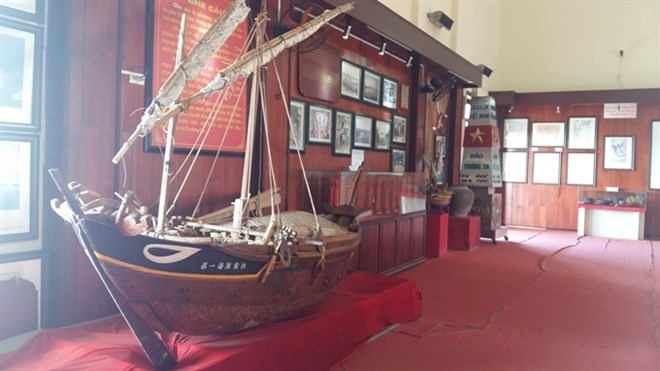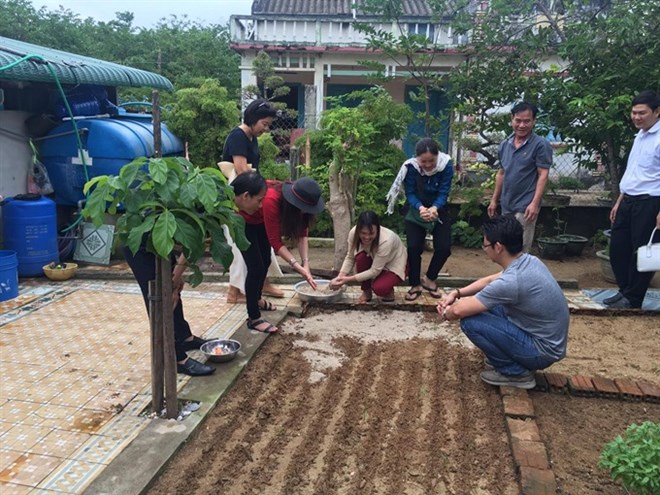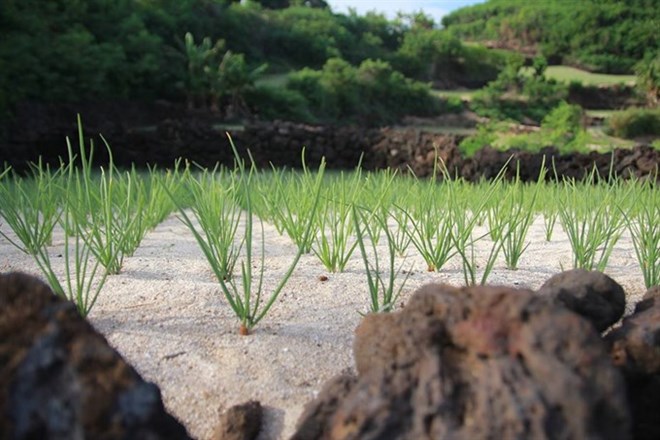Ly Son Island, 30km off the coast of central Quang Ngai province, has had a face-lift since connecting to the national power grid in 2014. But while islanders have benefited from the rapid changes, serious environmental challenges are also arising.

Coral reefs off the coast of Ly Son Island. (Photo: VNA)
Electronics shops, mobile phones, internet services and power-driven facilities have mushroomed in the island. Hotels, guest houses, restaurants and tourism service have been rapidly built as islanders seek prosperity from tourism rather than labour intensively on farms.
“It’s a great change. Power helps us light up the island. More speed-boat trips and cargo ships gradually bring the island closer to the mainland for trade, tourism and investment,” said islander Nguyen Thanh Hung.
“It takes only an hour to travel by speed-boat between the island and mainland Sa Ky port. Trade has been boosted with the island,” Hung said, adding that a sea trip between the island and mainland took one day 20 years ago.
The 54-year-old islander now makes his living from a grocery shop and a garage after two decades running a farm and fishery.
“Farmers have now increased their crops from one to four. Power equipment created higher productivity,” he said.
According to archaeologists, Ly Son Island is a dormant volcano. The terrain of the island was created from eruptions 25 to 30 million years ago, leaving landscapes with rocks, caves, cliffs, rock arches and a lake.
He said a fresh water lake on Thoi Loi Mountain was formerly the crater of a volcano. It is popular with visitors.
“The island has abundant relics related to the Sa Huynh, Champa and Dai Viet (or Great Viet) cultures that existed on the island for thousands of years,” Dr Pham Quoc Quan, a member of the National Heritage Council, said.
“Ceramic fragments and other antiquities from archaeological excavations revealed the first community living in the island belonged to the Sa Huynh culture between 2,500 and 3,000 years ago.
This was followed by the Hindu Champa culture. Migrants from mainland Quang Ngai then settled on the island to set up the third layer of culture – the culture of the Vietnamese people,” Quan said.
“Architecture, pagodas, temples and ancestor temples were built by the Vietnamese settlers,” he said.

Replica of one of the boats that carried troops on patrol in the Hoang Sa (Paracel) Islands of Vietnam. (Photo: VNA)
Quan also added that the island was a safe dock for merchant boats on busy trading routes centuries ago.
He said islanders still preserved the annual Hoang Sa festival. This is held to pay tributes to local men who enlisted in the Hoang Sa Flotilla for hundreds of years.
The group was set up under the Nguyen dynasty to patrol the Hoang Sa (Paracel) and Truong Sa (Spratly) archipelagos and salvage goods from the many wrecks, catch fish and maintain a Vietnamese presence over the area.
The festival, which includes a requiem for those who had died on the sea patrol missions, a procession of four supernatural creatures and the release of lanterns, has been recognised as the National Intangible Heritage.
Ly Son is also known as "" in Vietnam, as its farmers have produced high quality garlic and onions for the country. The soil they were grown in was a mixture of basalt and sand taken from the sea off the beach of Ly Son. Nguyen Thi Thuan, a farmer, said garlic from the island was quite different to products that grow elsewhere in Vietnam.
“It’s not too hot and has a sweet scent. A kilo of common multiple clove garlic could sell for 80,000 VND (3.50 USD), but our single clove garlic could fetch 700,000 VND (31 USD) for one kilo,” Thuan said, adding her small farm of onions earned 30 million VND (1,300 USD) each crop.

Tourists explore farms at a home-stay on the island. (Photo: VNA)
Tran Minh Khanh, a hotel owner, said his income was five times higher since tourism boomed.
“Our 60-room hotel, which offer rooms from 250,000 VND (11 USD) to 800,000 VND (35 USD) are almost 80 percent full at weekends, while we also offer bike rentals for 150,000 VND a day,” Khanh said. He said his family earned 50 million VND (2,200 USD) each month.
Islanders also offer home-stay services for only 60,000 VND (2.60 USD).
According to latest reports, 109 hotels, guest houses and 56 home-stays provide 650 rooms for more than 1,000 tourists each day.
Secretary of the Ly Son District Party Committee Nguyen Viet Vy said the island had almost doubled its revenue since its linked with the national power grid.
Vy said so far this year, the island’s production had earned 1.5 trillion VND (66 million USD), of which 52 percent was from agriculture and seafood.
He added revenue per capita reached 25 million VND (1,100 USD) per year.
Huynh Thi Phuong Hoa, deputy director of Quang Ngai’s Department of Cuture, Sports and Tourism, said 25 percent of the 800,000 visitors to the province also went to the island.
She said the province had planned to develop an eco-tour service and community-based tourism on the island to conserve nature.

High quality garlic is grown in sand and basaltic soil on Ly Son. (Photo: VNA)
However, expert Vu Cao Minh has warned that exploitation of beach sand for farming garlic and onions could result to damage to coral reefs around the island, while the boom in hospitality services could lead to a mass collapse of the underground water structure of the island.
Waste treatment, over-use of pesticides in farming and too many concrete structures would seriously affect the island’s landscape in coming years if no action was taken, Minh added.
National Heritage Council’s member Quan said the island should protect water resources in a sustainable way because over-use of underground water would cause desertification on the island.
The damage to coral reefs must be stopped, while the illegal dumping of rubbish and pollutants must be banned, Quan said.
An organic farming and environment-friendly manners should be adopted as part of sustainable development on the island, he suggested.-VNA